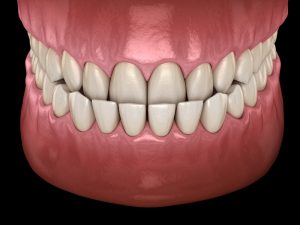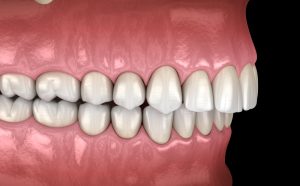Assessing occlusion: technology vs. tradition
Featured Products Promotional FeaturesPosted by: Dental Design 26th November 2023

Measuring occlusion is a vital aspect of practising dentistry that is well-informed and patient-centric. The ways in which occlusion is assessed have seen improvements, adaptions and ventures into new areas over the years. Perhaps the most pertinent advancement in recent decades has been the use of digital technologies and approaches: a market that is still relatively new and thriving with innovation. There are advantages and disadvantages to any promising new technology, and the use of digital in assessing occlusion has so far drawn both praise and hesitation from the dental profession.
An important step
From orthodontics to restorative care, occlusion and its harmony is paramount to successful, long-lasting outcomes. For instance, in implant dentistry, the literature postulates that occlusal overload is usually deemed one of the main causes of peri-implant bone loss and prosthesis failure.[i] There are also debates regarding occlusion and temporomandibular disorders (TMD), albeit still controversial:[ii] studies have concluded that ‘occlusal irregularities may be important contributing factors’ in certain TMD cases. Ultimately, poor occlusion can have certain ramifications for a patient’s oral health-related quality of life (OHRQoL), in addition to causing other personal and social issues.[iii] Thus, assessing occlusion is an important part of practise and, unsurprisingly, many modalities have been developed to ensure clinicians are able to capture information accurately.
The old and the new
 Traditional concepts have been tried and tested, and continue to be trusted in practice today. However, the benefits of emerging digital modalities cannot be denied. The literature is accruing more and more evidence to support the view that digitalised dentistry is introducing professionals to a new frontier. For other aspects of practise, such as patient satisfaction and revenue growth, digitalised methods are proving fruitful, too. One advantage of digital technology in practice highlighted by some clinicians is the potential time it saves for both the dental team and their patients. A study observing the reliability and time efficiency of digital and analogue bite registration techniques found the digital bite workflow to be 60% faster than the latter, with a clinically acceptable overall deviation of approximately 1mm.[iv]
Traditional concepts have been tried and tested, and continue to be trusted in practice today. However, the benefits of emerging digital modalities cannot be denied. The literature is accruing more and more evidence to support the view that digitalised dentistry is introducing professionals to a new frontier. For other aspects of practise, such as patient satisfaction and revenue growth, digitalised methods are proving fruitful, too. One advantage of digital technology in practice highlighted by some clinicians is the potential time it saves for both the dental team and their patients. A study observing the reliability and time efficiency of digital and analogue bite registration techniques found the digital bite workflow to be 60% faster than the latter, with a clinically acceptable overall deviation of approximately 1mm.[iv]
Alongside time, comfort is an incredibly important part of the treatment process, and a key player in facilitating an improved patient experience. Dental anxiety still impedes good oral health for many patients, and so methods of reducing discomfort should be sought. During impression taking procedures, studies show that patients report an inclination towards digital methods, such as intraoral scanners (IOS), due to the level of comfort they provide.[v] Improved comfort has many positive ramifications, including increased treatment acceptance, and reduced repeat appointment visits and retreatments.v Traditional methods of recording occlusion, namely wax and acrylic resins, certainly still provide clinically acceptable results, but patient demand may impact their uptake.[vi]
Taken with a grain of salt
Like any new development, there are always drawbacks and complications that require finessing as the technology matures: digitalised dental tools and equipment are not exempt. Some of the debate  around the adoption of digital technology includes its initial monetary investment, and time-and cost-investments for team training, to ensure the tools and equipment are being utilised properly and safely. For many professionals, time is of the essence and prioritising training may not be feasible for a myriad of reasons.
around the adoption of digital technology includes its initial monetary investment, and time-and cost-investments for team training, to ensure the tools and equipment are being utilised properly and safely. For many professionals, time is of the essence and prioritising training may not be feasible for a myriad of reasons.
Despite the impressive performance of digitalised tools, the technology just isn’t quite perfect, not yet. Researchers, when highlighting the efficacy of digital technologies, do stress that the accuracy of digital devices need to be further analysed: it remains important to be aware of the limitations of this technology.[vii] Taking the example of occlusal analysis, precision is incredibly vital to ensure that all necessary information is recorded correctly – for some clinicians, traditional materials still do the best job, and this will be incentive to stick with traditional methods until a time that new, more advanced digital solutions are available. Further development is required to finesse this technology and smooth out any issues. As the years progress, it will be interesting to see how these potential issues are solved and whether this influences digital adoption in more practices.
Food for thought
It cannot be denied that digital advancements in the field of dentistry have completely transformed the dental workflow, as well as relationships with peers and patients. With areas like occlusal assessment, digital technology is beginning to provide some new benefits – or at least it could, when it’s ready. However, all new innovations, especially in a relatively new market like digital dentistry, require careful consideration and the maturation of their efficacy is expected over the coming years. For those looking to introduce digital tools into their workflow, it is vital to weigh up the potential complications with the benefits for optimal results.
Stephen Claffey Managing Director of Dental Pathway™ and the Independent Dental Advisory Board™
[i] Verma, M., Nanda, A. and Sood, A. (2015). Principles of occlusion in implant dentistry. Journal of the International Clinical Dental Research Organization, [online] 7(3), p.27. Available at: http://www.jicdro.org/text.asp?2015/7/3/27/172924 [Accessed 3 Sep. 2023].
[ii] Al-Ani, Z. (2020). Occlusion and Temporomandibular Disorders: A Long-Standing Controversy in Dentistry. Primary Dental Journal, [online] 9(1), pp.43–48. Available at: https://journals.sagepub.com/doi/full/10.1177/2050168420911029 [Accessed 3 Sep. 2023].
[iii] Alrashed, M. and Alqerban, A. (2020). The relationship between malocclusion and oral health-related quality of life among adolescents: a systematic literature review and meta-analysis. European Journal of Orthodontics, [online] 43(2), pp.173–183. Available at: https://academic.oup.com/ejo/article/43/2/173/5917509 [Accessed 3 Sep. 2023].
[iv] Nuytens, P., D’haese, R. and Vandeweghe, S. (2022). Reliability and Time Efficiency of Digital vs. Analog Bite Registration Technique for the Manufacture of Full-Arch Fixed Implant Prostheses. Journal of Clinical Medicine, [online] 11(10), p.2882. Available at: https://www.mdpi.com/2077-0383/11/10/2882 [Accessed 4 Sep. 2023].
[v] Yuzbasioglu, E., Kurt, H., Turunc, R. and Bilir, H. (2014). Comparison of digital and conventional impression techniques: evaluation of patients’ perception, treatment comfort, effectiveness and clinical outcomes. BMC Oral Health, [online] 14(1). Available at: https://www.ncbi.nlm.nih.gov/pmc/articles/PMC3913616/ [Accessed 4 Sep. 2023].
[vi] Camcı, H. and Salmanpour, F. (2021). A new technique for testing accuracy and sensitivity of digital bite registration: A prospective comparative study. International Orthodontics, [online] 19(3), pp.425–432. Available at: https://www.sciencedirect.com/science/article/abs/pii/S1761722721000875 [Accessed 4 Oct. 2022].
[vii] Revilla-León, M., Kois, D.E., Zeitler, J.M., Wael Att and Kois, J.C. (2023). An overview of the digital occlusion technologies: Intraoral scanners, jaw tracking systems, and computerized occlusal analysis devices. [online] Available at: https://onlinelibrary.wiley.com/doi/10.1111/jerd.13044 [Accessed 4 Sep. 2023].









